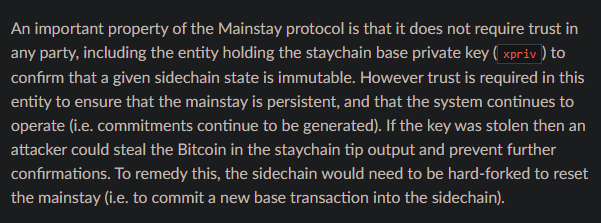Thread
At my local BitDevs meetup the other day, someone asked: how is this sovereign rollup technique different than blockchains like Stacks that put a hash of their blocks into bitcoin transactions?
The first difference is that unlike a sovereign rollup, Stacks is able to re-org independently of bitcoin. Worth noting that, unlike bitcoin re-orgs, attempts to re-org Stacks have to be made public from the start. This is described in SIP-001:
github.com/stacksgov/sips/blob/main/sips/sip-001/sip-001-burn-election.md
github.com/stacksgov/sips/blob/main/sips/sip-001/sip-001-burn-election.md
The second difference is data availability. Because Stacks only stores a hash of its blocks in bitcoin transactions, not the full block data, Stacks has different data availability guarantees than bitcoin. We'll come back to data availability and why it matters later.
There are other protocols that only put a hash of a blockchain into bitcoin transactions and yet _do_ fully inherit bitcoin double-spend security.
@commerceblock Mainstay is one such protocol:
commerceblock.readthedocs.io/en/latest/mainstay/
@commerceblock Mainstay is one such protocol:
commerceblock.readthedocs.io/en/latest/mainstay/
Mainstay differs from sovereign rollups in two key ways.
The first difference is Mainstay's reliance on third parties to maintain forward progress. If the third party fails, then the Mainstay chain will need to hard fork to restart.
commerceblock.readthedocs.io/en/latest/mainstay-protocol/index.html
The first difference is Mainstay's reliance on third parties to maintain forward progress. If the third party fails, then the Mainstay chain will need to hard fork to restart.
commerceblock.readthedocs.io/en/latest/mainstay-protocol/index.html
The second difference between Mainstay and sovereign rollups is, as with Stacks, data availability.
Like Stacks, a Mainstay chain only puts a hash of its blocks into bitcoin transactions, not the full block data, so Mainstay chains have different DA guarantees.
Like Stacks, a Mainstay chain only puts a hash of its blocks into bitcoin transactions, not the full block data, so Mainstay chains have different DA guarantees.
Bitcoin-grade data availability is perhaps most important for rollups built on top of sovereign rollups. These rollups rely on the data availability guarantees of their parent chain (in this case, the sovereign rollup) so bitcoin-grade data availability is especially valuable.
Mentions
See All
Muneeb Ali @muneeb
·
Mar 5, 2023
Good thread! Imp to note that reorg independently of Bitcoin goes away with Stacks Nakamoto release (to be more precise no way to independently reorg after 150 blocks). The harder tech challenge for both Stacks layer and sovereign rollups is BTC bridge. So upcoming sBTC…


